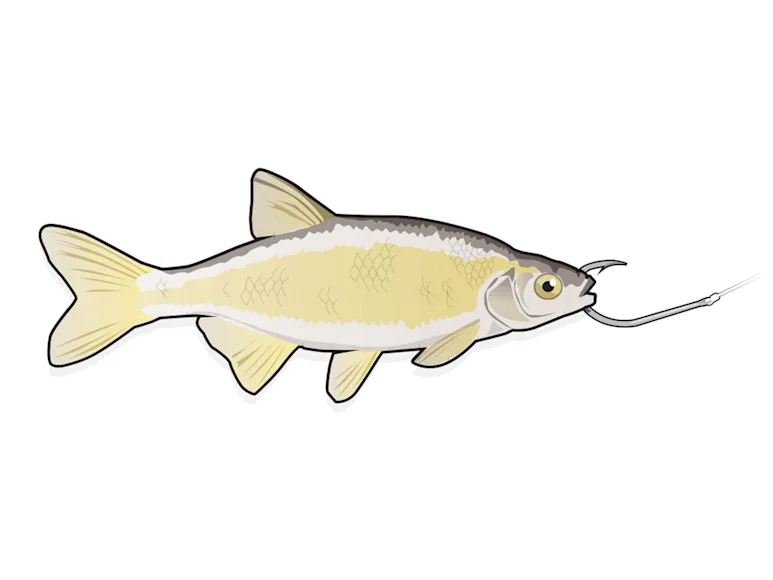_We may earn revenue from the products available on this page and participate in affiliate programs. Learn more ›
_
For most anglers, it all started with a worm, a bobber, and a hook. From there, many grow up to become artificial enthusiasts, but the smart ones never forget the power of those worms. You can argue all you want about the potency of a particular fly or lethality of that hot new crankbait, but at the end of the day, more big fish fall to natural baits than every lure and fly combined. A spinner will never look better than a live shiner; a hair jig will never smell exactly like a real hellgrammite. And despite what some people might think, there is a lot more art and technique wrapped up in bait fishing than simply sticking something on a hook and making a cast. While delivery methods are practically innumerable, there are some rules—if you will—abou the simplest aspect of bait fishing
: where to put the hook. Believe it or not, where you jab a shiner or thread a cricket can spell the difference between a bite-off and a solid connection, or a hand sized bluegill and a dinner plate sized bluegill. I’ve outlined 15 hook placements for some of the most popular baits to ever hit the water. Stick to these guidelines (get it?) and I promise you’ll stick more fish.

Night Crawler
The night crawler is one of the most popular live-bait rigs.
The night crawler. It’s arguably the most used live bait, period. From bluegills to blue cats, walleyes to white bass, good luck finding a freshwater species that refuses to gobble one. Given that night crawlers appeal to so many species, there is no single way to put one on a hook. You may only need to tip the point with a tiny piece for perch, or put five whole ones on a hook for catfish. That being said, a whole single worm on a hook is what I believe is the most ubiquitous presentation for a variety of species, so that’s the focus here. The keys are the right amount of threading to dangle. As worms can be pulled off easily, you’ll want to thread a whole crawler up the shank three or four times, starting near one end of the bait. A baitholder hook really helps with securing the worm. The goal is to have a quarter to a half of the remaining worm dangling below the hook bend. The dangling end provides the wiggle that attracts fish, and larger bass, cats, or walleyes will usually take the entire bait in one shot. However, if you’re hunting for big panfish, smaller players can nip the trailing tail without easily pulling the whole worm off, giving you a longer soak time and a better chance that after the tail is gone, the next monster shellcracker to come along will slurp down what’s remaining with no hesitation and get stuck.

Shiner/Minnow (Lip Hook)
This rigging method allows the shiner to swim and wiggle.
As with many live baits, there are several ways to pin a fresh, wriggling shiner or minnow, but the most common is right through the lips. However, there are pros and cons to this method, largely determined by the size of the bait and the species you’re targeting. Piercing through the lips definitely does the least amount of damage to the bait and also lets it swim most naturally, theoretically allowing it to stay lively on the hook for a longer period of time. When using small baits such as rosy reds or fatheads, lip hooking is a must, as these tiny swimmers are usually too delicate to handle the trauma of body hooking. At the same time, these little baits are often used for panfish or trout, which will eat the entire minnow in one shot. With larger shad or shiners, lip hooking is tops when free-lining a bait without any weights or floats, although lip-hooked baits will perform just as well sunk or suspended. The trade off is that larger lip-hooked baits can be pulled off fairly easily. If the bass or pike you’re after eats headfirst like it’s supposed to, you’re golden. If you get short struck, or the blow is delivered to the tail or body exclusively, the hook may or may not end up in the fish’s mouth.
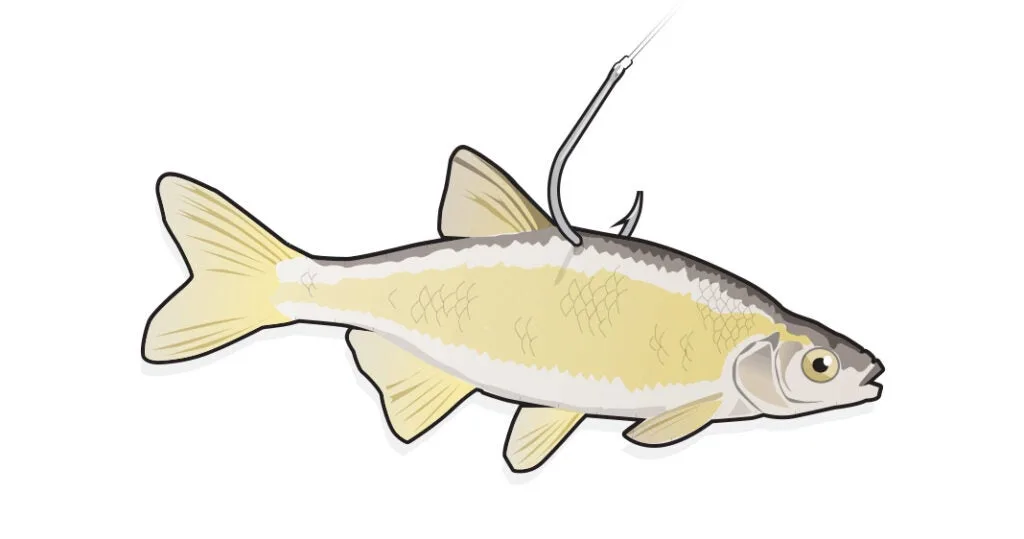
Shiner (Dorsal Hook)
A back-hooked shiner will swim in wide circles.
Whereas lip hooking a live shiner allows the bait to swim most naturally, running the point through the bait’s back just forward of the dorsal fin has the complete opposite effect. Of course, it can pay off huge. With constant line tension pulling the shiner sideways, this hooking method will cause the bait to flash and change direction a lot more as it struggles. Rig a back-hooked shiner under a float, and it’s going to swim in wide circles as it tries to free itself. While the bait is going to wear out faster than if it were lip-hooked, it’s going to put out a lot more vibration and the kind of distress signals that get gamefish fired up. Over the years, I’ve noticed that a struggling back-hooked shiner tossed next to a laydown or pad edge often gets eaten faster than a lip-hooked bait. Likewise, it’s the only way I’ll hook a shiner if I’m targeting toothy fish like pickerel or pike. In my experience, having the hook in the bait’s back reduces the odds of a bite-off since the fish most often T-bone the shiner when presented this way. Pike and pickerel often suck in a lip-hooked shiner from the rear, and draw it so far back in their throat that their mouth closes around the line or leader. And if it’s not steel, snip it goes when you set the hook.
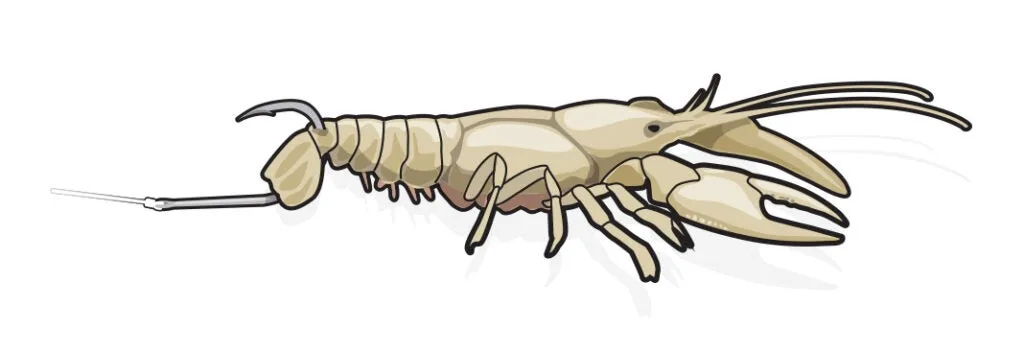
Crayfish
This is a simple, effective way to rig a crayfish.
Spring through fall, if you get a live crayfish in front of a brown or green bass, it’s rare that it’ll pass on the crunchy treat. And here’s an insider tip: try live crayfish in trout streams in October and November. Little browns won’t touch them, but big, bad, 20-plus-inch momma sure will. While rigging one of these baits is very simple, there’s methodology in that simplicity. Crayfish swim backwards, therefore, you want to run the hook up through the first or second joint closest to the tail, and you’ll score more positive hook sets with the point oriented up through the back. When free drifting, this hook placement provides the most natural presentation, allowing the crayfish to move its legs and flare its claws defensively when a fish gets close. If you’d rather peg a crayfish to the bottom with some weight, this rear hooking style will allow them to crawl naturally around the bottom, and even kick away backwards naturally provided you don’t use too heavy of a hook.
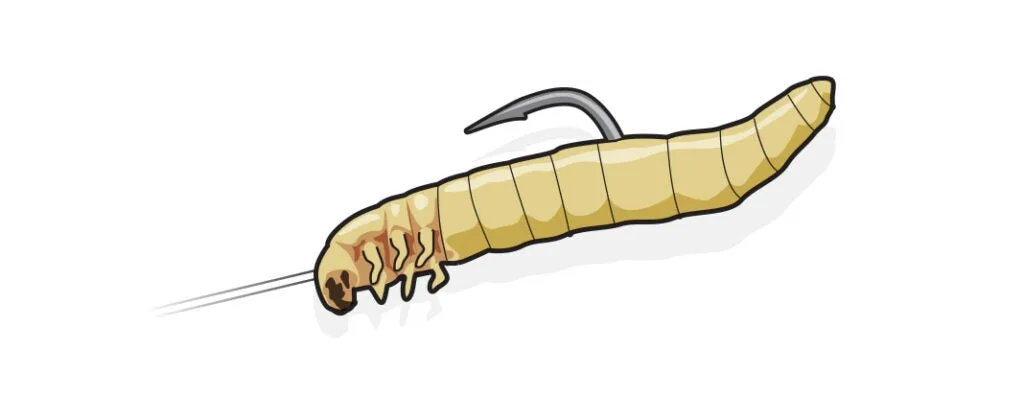
Mealworm
Mealworms are deadly trout and panfish bait.
The beauty of a mealworm is that it actually matches a wide variety of forage. To a trout, a “mealie” can represent anything from an emerging stonefly to a drowned hopper to a big inchworm that dropped off a tree. But regardless of what a trout thinks it is, it’s more likely to eat it if it’s drifting naturally. The best lesson I ever got on fishing these worms was from Matt Wettish, a Connecticut angler known as the “Mealie Master
.” Wettish fishes ultra-light two-pound-test line, and threads his worms on a light size 12 scud hook used for fly tying. Only the tip of the point protrudes through the bait’s back, helping achieve a natural drift in which the worm stays perfectly straight as it rides the current. If Wettish needs weight, he adds tiny split shot to the rig one bead at a time until he has just enough drop-down power to barely tick the bottom.
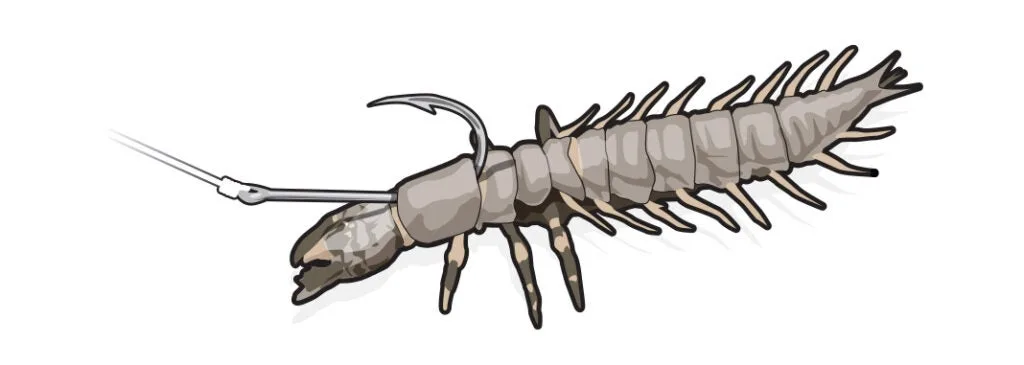
Hellgrammite
Rigging a hellgrammite this way allows you to catch multiple fish on the same bait.
The hardest part about fishing live hellgrammites? Getting your hands on some. Few and far between are the bait shops that stock them (at least where I live), and seining your own can take dedication, not to mention a stream or river with enough ’mites in it to seine in the first place. However, put one on a hook and the most shut-down, lock-jawed, don’t-want-nothin’ smallmouths and trophy trout will race over to eat the ugly little sucker. Even a piece of a fresh hellgrammite will get chowed in a flash, and the consensus is that it’s because the smell of a hellgrammite is so powerful, fish just can’t resist. If you are lucky enough to hit the river with some live hellgrammites in tow, all you have to do is slip a light-wire long-shank hook under the thick collar right behind the head. Not only does this hooking point allow the larvae to wiggle during the drift, it can also save you a lot of precious baits. Hellgrammites are hearty, and rigged this way, they’ll often slide up your line like a plastic worm after the hit. All you have to do is slide the bait back down into position before your next cast. I’ve literally caught upwards of a dozen smallies on a single hellgrammite before needing to swap out for a freshie.
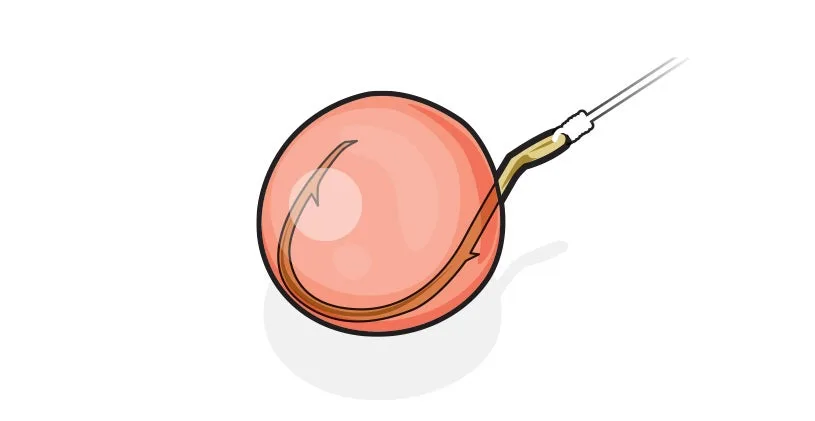
Salmon Egg
A single salmon egg is unresistible to rainbows from New Jersey to Alaska.
Whether you strip and cure your own salmon eggs or you just buy a jar of cheese-flavored Atlas-Mike’s like I used to before every opening day, trout fishermen from Alaska to New Jersey can’t deny the power of these little morsels. Yes, I know that steelhead and salmon guys fish them in sacks or clusters, but I’m talking about drifting a loner down a juicy run for a rainbow, be it stocked or wild. The problem with salmon eggs—even the cured ones—is that they’re pretty soft, making it easy for them to fly off the hook when you cast. With that in mind, while you can stick a solo egg on any old small hook, they make dedicated egg hooks for a reason. These tiny short-shanks that often feature a single barb above the bend are perfectly designed to hold an egg as securely as possible. Start by piercing the egg shallow along one edge, not through the middle. Next, slide it up the shank toward the eye, and then rotate the egg inward towards the point. Now slide the egg back down the shank, allowing it to seat over the point. When seated properly, the hook should be entirely hidden with the exception of the eye.
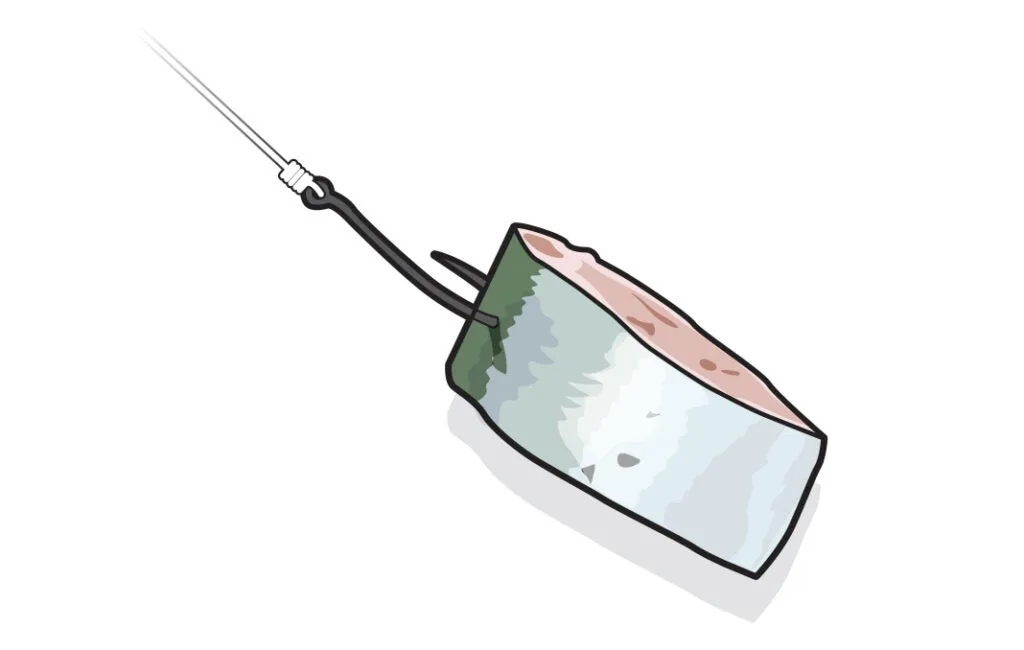
Chunk
The ever versatile chunk bait.
Maybe you’re hacking up some gizzard shad for blue catfish. Perhaps you’re slicing fresh menhaden for striped bass. You might even be sawing a fresh carp for alligator gar. There are lots of reasons for soaking chunks, but regardless of the target, there is a commonly accepted “best” method for hooking them. In many cases—particularly with stripers or cats over 15 pounds—there will be no hesitation; the fish will Hoover that bait off the bottom and start moving away. That’s not the case, however, with all species. Even giant gar take their sweet time working a chunk into their throats. Smaller cats may pick a chunk up and drop it repeatedly before committing. But whether you have to wait for the right run to strike or are dealing with a fish that gobbles and heads for the hills, you want the hook point exposed. If you completely hide the hook in the chunk and it doesn’t punch through when you swing, the entire bait and hook can pull right out of the fish’s mouth. Only bury the hook when you absolutely can’t score an eat with the hook exposed. Otherwise, pierce the bait chunk just once through the thickest part of the back, going through fairly shallow. Don’t ever run the hook under the spine, as you want it to pull out easily when you set, and if it has to get through that piece of bone, you may end up with some missed connections.

Leech
Leeches work for walleyes, bass, and even trout.
Though most commonly used in the walleye game, I’ve caught some pretty nice trout and smallmouths on bloodsuckers over the years. In my opinion, they’re fairly underutilized baits, and that shouldn’t be the case because they offer lots of advantages. For starters, leeches are significantly tougher than night crawlers, often withstanding multiple hits before getting ripped of. It’s also hard to beat the dark, contrasting color and sexy undulation of a live leech. However, as they’re long and flat, leeches can be just as potent dead. When a leech dies, I’ll work it almost like a lure, twitching and hopping the juicy ribbon through eddies and riffles. All you have to do is pierce a leech once through the thick part of the head and add a few split shot up the line a foot or so. They’re positively lethal on a jighead, too.
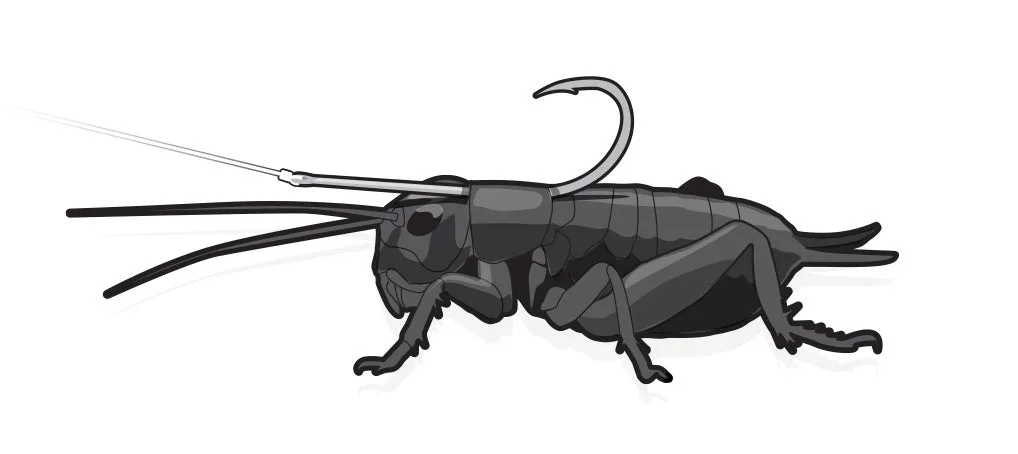
Cricket
Crickets are killer panfish bait in the north and south.
Head down south and you’ll find live crickets in almost every bait shop. While not as common and popular in the north, these bugs are killer panfish baits, often fooling heavier ’gills than the plumpest night crawler. While crickets are purchased live, the truth is they don’t stay that way for long in the water no matter how you hook them. That’s why many anglers thread a cricket onto the hook, running the shank through the entire body and pushing the point out through the head. However, if you want to keep a cricket wiggling a little longer, slip a light-wire hook under the collar behind the head so the hook bend rests on the bait’s back. Fished in combination with a bobber, this hooking style will help keep the bait struggling on the surface for a bit. However, if the bait drowns—or you decide to add a split shot or two—this placement will be equally effective when a fish crunches the bait subsurface. Most of a cricket’s body is very soft, so if you were to just pierce the hook through the abdomen, there’s a good chance the bait will fly off when you cast.
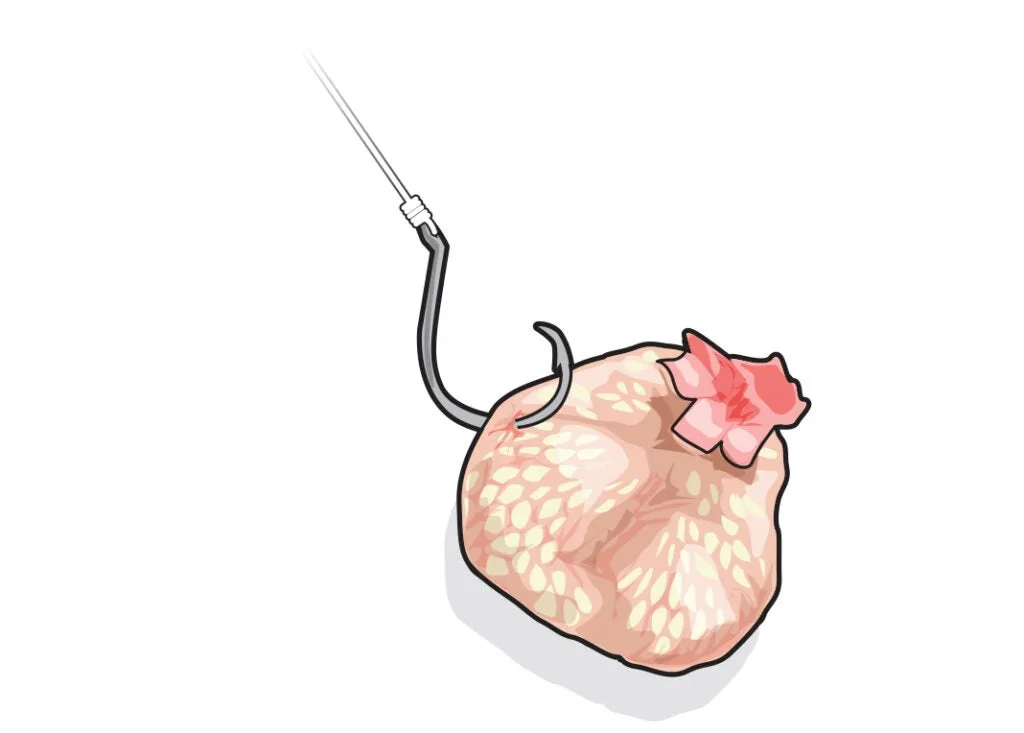
Chicken Livers
Chicken livers will put a hurting on catfish like no other bait.
They’re messy, they’re stinky, and they’re kind of a pain to rig, but, man, do chicken livers ever put a hurting on catfish. By the way, they’ll put a hurt on freshwater stripers in certain scenarios, too. No matter what you’re after, hooking remains the same. Piercing livers directly on a hook is the equivalent of trying to put Jell-O on a hook. It’s not going to stay there very long even if it survives the cast. That’s why liver enthusiasts wrap their innards in mesh netting or nylon cut from a pair of pantyhose. Once the slimy guts are tied up in a bite-sized sack, simply run the hook shallow through the edge of the bag, making sure the point passes back out through the sack material. You don’t want to bury the hook deeply into the bag, as the material could get in the way of the point when you set. The bag material provides a firm hold for the hook while simultaneously letting all those tasty liver juices seep out and tempt a trophy channel cat.
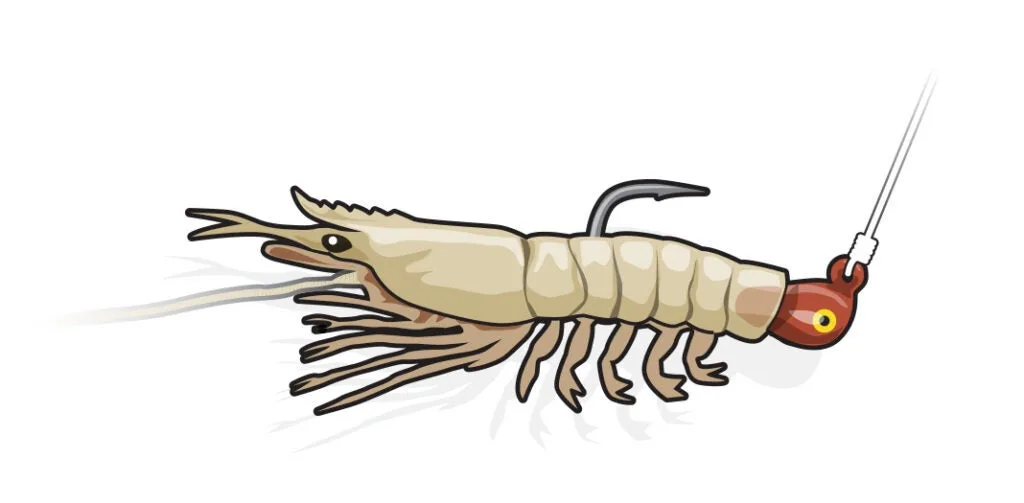
Shrimp (Jighead)
This is a versatile presentation for shrimp, no matter what you’re fishing for.
In the southern Atlantic and Gulf states, live shrimp are the go-to baits for everything from puppy drum and sheepshead to monster tarpon and snook. Depending on the situation and type of water you’re fishing for these species, there are two common hooking styles. The first is on a jighead, essentially giving you a live bait presentation with an artificial jig action. Start by pinching the tail off the shrimp. Then you can simply thread the hook up through the tail end so it protrudes from the back far enough up the body that the jighead seats perfectly where the real tail used to be. A shrimp will stay lively for quite a while rigged this way, and though it can no longer swim naturally (you have to add the action) it will still move its legs and twitch its antennae. You can hop a jighead-rigged shrimp across the bottom for flounder or hang it below a popping cork to work a fixed depth for seatrout. It’s an incredibly versatile presentation.
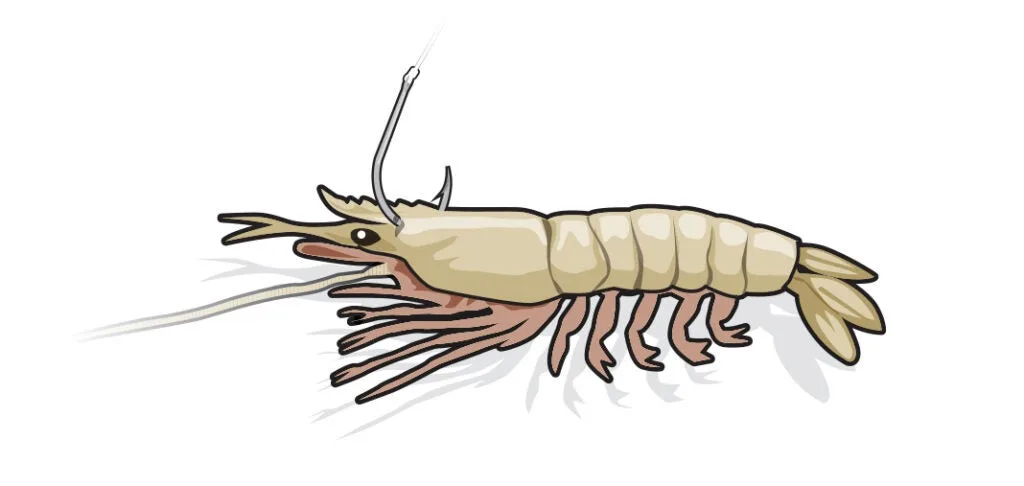
Shrimp (Horn Hook)
This rigging method allows the shrimp to swim as freely as possible.
Sometimes the most effective presentation with a live shrimp is allowing it to swim as freely and naturally as possible. To achieve this, hook the bait through the head. The trick, however, is being precise with hook placement. When looking at the translucent head of a shrimp, you’ll clearly see a dark spot roughly an inch behind the eyes. That’s the shrimp’s brain, and piercing it will kill the shrimp in pretty darn fast. You want to run the hook between the eyes and brain, passing it under the hard horn. Pinned properly, the horn will hold the bait on the hook and the shrimp will stay lively for hours. Putting the weight of the hook at the head allows the bait to naturally crawl forward across the bottom or dart away backwards if it gets spooked. This is a great presentation for weightless free-lining to fish like tarpon and snook that are tucked under docks or mangroves in moving tidal current.
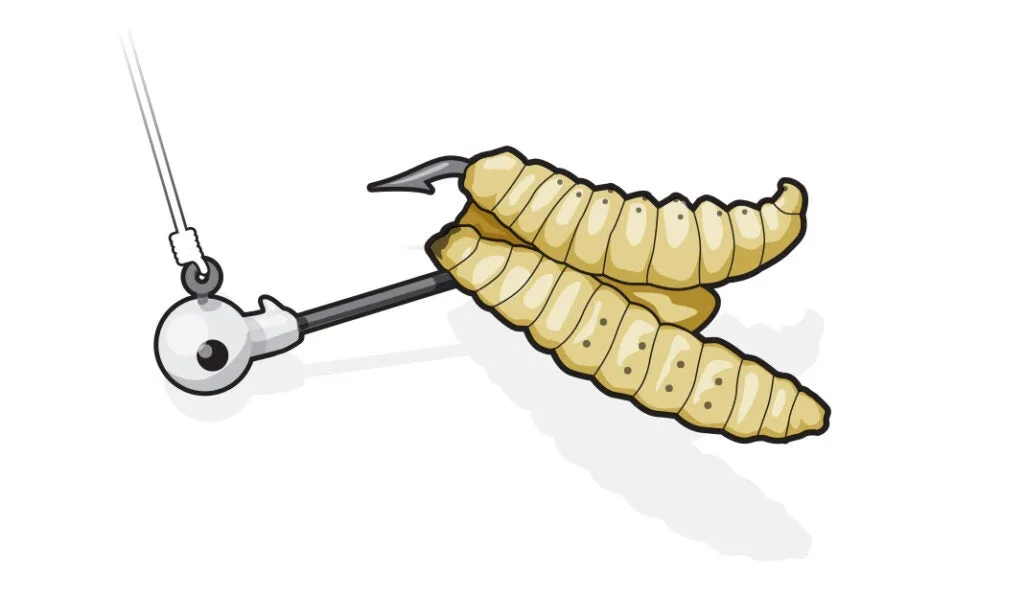
Wax Worm
Wax worms are classic bait for ice fishermen.
These tiny maggots are often referred to as “waxies,” and while they make fine panfish and trout food all year long, this bait is definitely tied closest to ice fishing. Some anglers argue that the smell of a waxie’s puss-like guts wafting in the water after being pierced on a hook is what drives fish nuts. Others say it’s more the color and action of a wax worm dancing on a hook while being jigged. It makes no difference if one answer is correct. The bottom line is that these itty-bitty baits will up your ice game for everything from crappies to perch to heavy lake trout. One worm is never really enough; pierce three or four through the head on a bare or dressed jighead and start working the column on the hardwater. I’ve watched underwater video of perch just staring at a plain jig without making a move. Tip the same jig with a few waxies and send it back down and suddenly they’re fighting over it.
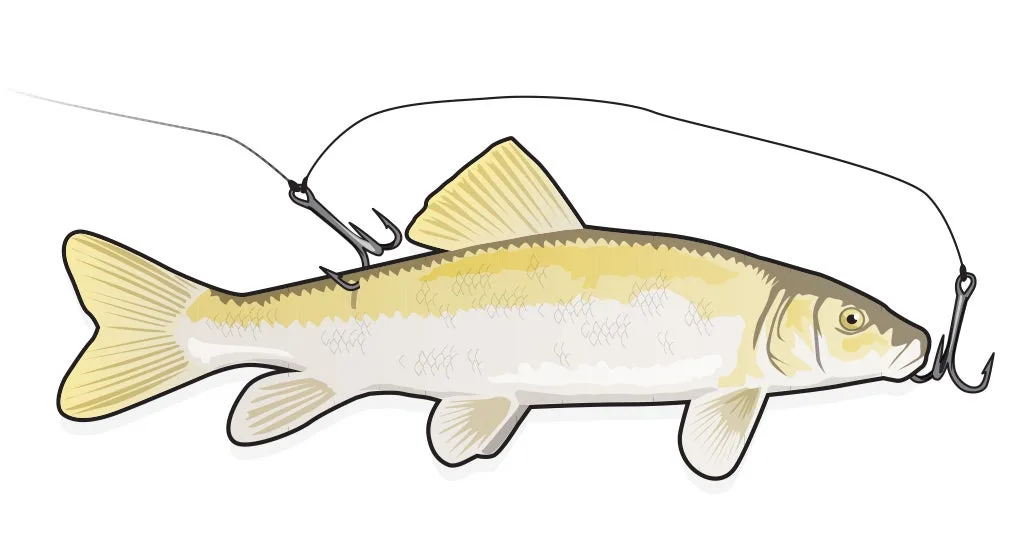
Sucker
Oftentimes a sucker will get muskies to bite when nothing else will.
“Go big or go home.” It’s so cliché. But if you’re trying to tempt a mammoth muskie with live bait, truer words were never spoken. While several species of livie can be employed for this task, none is more popular or productive than a sucker. Whether you’re swinging for the fences with a 14-plus-inch bait, or soaking a more modest 8- to 10-inch sucker, the rigging is the same. While there are many variations of what is known as the “quick strike rig,” the most basic form places a treble hook through the bait’s lips or nostrils, and a second stinger treble in the sucker’s back or side between the tail and dorsal fin. The hooks are connected via steel or wire leader, with a second length of leader running to the main line from the tail hook. Important to note is that the configuration technically makes the head hook the rear hook. This has purpose, because a muskie is likely to eat a sucker head first, and you don’t want extra wire or the main line getting in the way when it does. The hook placement also helps the sucker swim more naturally, as many anglers stick a live sucker in a rod holder while casting lures, the idea being that a following fish that snubs artificials may grab the struggling sucker on its way back to the depths.

